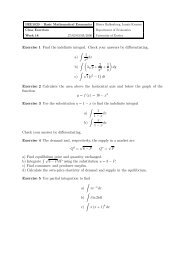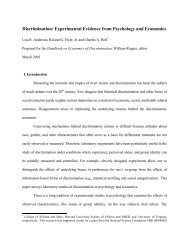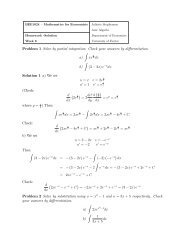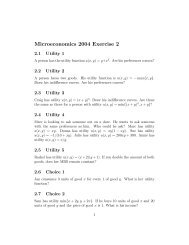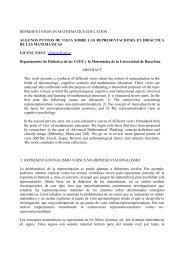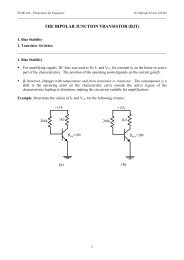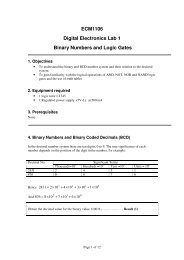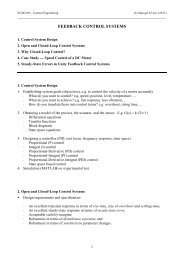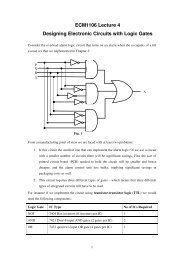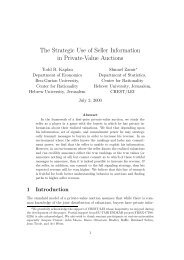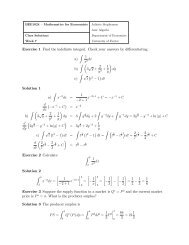are led to believe it is based on their true painting preferences. We decide not to use a r<strong>and</strong>omassignment based on our no-deception rule for our subject pool. The use of true preferences mightcause two potential problems, unbalanced group size 2 <strong>and</strong> correlation between painting <strong>and</strong> socialpreferences. To investigate whether they affect decision making in some systematic manner, weperform two types of analysis. First, we examine the correlations between group size <strong>and</strong> individualchoices (<strong>and</strong> subsequent earnings), as well as the correlation between individual paintingpreferences <strong>and</strong> individual choice. We find no significant correlation in either case. Furthermore,we find that individual painting preferences are not correlated with demographics. Second, we includethe group size <strong>and</strong>/or individual painting preferences as additional covariates in all relevantregression analyses in Section 5 <strong>and</strong> find that neither coefficient is different from zero statisticallyor economically. Inclusion of these variables causes very little change in coefficient estimates ofall other variables. Therefore, we conclude that unequal group size does not add confounding effectsto the impact of a sole differentiation between ingroup <strong>and</strong> outgroup. Our design of groupingparticipants based on true painting preferences does not affect our estimates of group identity onsocial preferences.After being categorized into two groups, subjects were given the answer key 3 to the artists <strong>and</strong>subsequently participated in a second task that involved group communication via a chat programon computers. The second task was to answer two questions on which artist made each of two additionalpaintings. 4 Given ten minutes, subjects voluntarily exchanged information with own-groupmembers via a chat program to help one another obtain correct answers. Separate chat channelswere used so information could be shared only within a group. Though any information was allowedduring chatting, conversations focused mainly on the paintings. Experimenters monitoredthe chat process from the server <strong>and</strong> log files were saved subsequently. Everyone was free to submitanswers individually after the chat. One hundred tokens were rewarded to each participant foreach correct answer. 5 This part of the design is used to enhance group identity.In the second stage of the treatment sessions, every subject was asked to allocate a given numbersof tokens between two other anonymous participants. No one was allowed to allocate tokensto herself. This feature of the experimental design is used widely in the minimal group paradigm insocial psychology. Psychologists consistently find ingroup favoritism <strong>and</strong> outgroup discrimination,i.e., individuals allocate significantly more rewards to those from their own group <strong>and</strong> less to thosefrom a different group. We adopt this design feature for two purposes: to replicate the findings inthe social psychology literature <strong>and</strong> to enhance group identity further. Turner (1978) finds that thisother-other allocation procedure, if followed by self-other allocation, can help enhance the senseof group identity. 62 In our sample, 40% of the participants prefer Klee while 60% prefer K<strong>and</strong>insky.3 The five pairs of paintings are: 1A Gebirgsbildung, 1924, by Klee; 1B Subdued Glow, 1928, by K<strong>and</strong>insky; 2ADreamy Improvisation, 1913, by K<strong>and</strong>insky; 2B Warning of the Ships, 1917, by Klee; 3A Dry-Cool Garden, 1921,by Klee; 3B L<strong>and</strong>scape with Red Splashes I, 1913, by K<strong>and</strong>insky; 4A Gentle Ascent, 1934, by K<strong>and</strong>insky; 4B AHoffmannesque Tale, 1921, by Klee; 5A Development in Brown, 1933, by K<strong>and</strong>insky; 5B The Vase, 1938, by Klee.4 Painting #6 is Monument in Fertile Country, 1929, by Klee, <strong>and</strong> Painting #7 is Start, 1928, by K<strong>and</strong>insky.5 75% of the participants provided correct answers to both paintings. 21% provided one correct answer. Only 4%provided zero correct answer.6 In Turner (1978), participants were asked to allocate tokens in two conditions. In one condition, everyone wasasked to allocate awards to two other individuals (other-other) before dividing awards between herself <strong>and</strong> the otherperson with whom she was matched (self-other). In the other condition, the order was reversed. Turner finds anorder effect on whether one was willing to trade self-interest for other’s welfare. Specifically, ingroup favoritism wassignificant in the self-other choices if they were preceded by other-other allocations. However, it was not significantwhen the order was reversed.6
In our study, the stage of other-other allocations had five rounds. From round 1 to round 5, thetotal number of tokens to be allocated increased from 200 to 400 with an increment of 50 tokensin each round. We used the strategy method to elicit participant strategy profiles. 7 During eachround, everyone decided how to allocate tokens between another two people under three scenarios,if both of them came from her own group, if both came from the other group, <strong>and</strong> if one came fromher own group <strong>and</strong> the other from a different group. It was public information that only one roundof their decisions would be r<strong>and</strong>omly selected by the computer to compute payoffs. At the endof the second stage, a r<strong>and</strong>om sequence of ID numbers was generated by the computer to decidewho allocated tokens to whom. Everyone allocated tokens between the two participants whose IDsdirectly followed hers in the sequence. Therefore, one’s payoff in this stage was the sum of thetokens allocated to her by the two people whose IDs preceded hers in the r<strong>and</strong>om sequence.While the first two stages are designed to induce <strong>and</strong> enhance group identity, we use the thirdstage to investigate the impact of group identity on social preferences <strong>and</strong> economic outcomes.In the third stage, subjects made decisions in a series of two-person sequential move games selectedfrom Charness <strong>and</strong> Rabin (2002) 8 as well as an extension of some of the games. AppendixA presents a description of the set of games as well as the summary statistics for each game.Specifically, we selected five two-person dictator games <strong>and</strong> sixteen two-person response games.Furthermore, to investigate the sensitivity of Player B’s response to the cost in self-benefit, weadded three games that were based on Berk31 (Charness <strong>and</strong> Rabin 2002) with a varied amountfor Player B payoff.The two-person response games fall into three categories. For games in the first category, Bincurs no cost to help or punish A. For games in the second category, B needs to sacrifice herown self-interest to help A. For games in the third category, B incurs a cost if she penalizes A.Subjects made decisions in seven to ten games in each session. For each game, each participantwas r<strong>and</strong>omly matched with another participant <strong>and</strong> they were r<strong>and</strong>omly assigned roles A or B. Nofeedback was given until the end of the experiment. This procedure is similar to that in Charness<strong>and</strong> Rabin (2002). In our design, we use the strategy method to solicit participant decisions undertwo scenarios: if the participant’s match is from the same group, <strong>and</strong> if her match is from the othergroup. At the end of the experiment, two of the games were r<strong>and</strong>omly selected by the computer tocompute the payoffs, as announced in the instructions. Experimental instructions are included inAppendix B.The post-experiment survey contains questions about demographics, past giving behavior,strategies used during the experiment, group affiliation, <strong>and</strong> prior knowledge about the artists <strong>and</strong>paintings. The survey <strong>and</strong> response statistics are included in Appendix C.[Table 1 about here.]Table 1 reports the features of experimental sessions, including Session Number, Treatment orControl, Game Set, Number of Subjects per Session, <strong>and</strong> Number of Subjects used in the analysis.Overall, 24 independent computerized sessions were conducted in the RCGD lab at the Universityof Michigan from January to July 2005, yielding a total of 374 subjects. We used z-Tree(Fischbacher 1999) to program our experiments. Most of our subjects were students from the7 See Charness <strong>and</strong> Rabin (2005) for a discussion of the use of strategy methods in experimental games.8 We thank Gary Charness for helping us select the games.7
- Page 1 and 2: Group Identity and Social Preferenc
- Page 3 and 4: ehavior. Deviations from the prescr
- Page 5: identity strength on cooperative be
- Page 9 and 10: while ρ(1 + a) measures the charit
- Page 11 and 12: Support. In Table 2, column 5 prese
- Page 13 and 14: when A is an outgroup match. When A
- Page 15 and 16: compared to outgroup matching, incr
- Page 17 and 18: By Result 5, we reject Hypothesis 6
- Page 19 and 20: induced identity, when matched with
- Page 21 and 22: APPENDIX A. Sequential Games with S
- Page 23 and 24: Based on your choices, you prefer t
- Page 25 and 26: [New Screen]Please record your deci
- Page 27 and 28: [New Screen, Game 1, Player A]In th
- Page 29 and 30: [New Screen, Game 3, Player B]In th
- Page 31 and 32: Appendix C. Post-Experiment Survey(
- Page 33 and 34: Session # Treatment or Control Game
- Page 35 and 36: Dependent Variables Prob(B rewards
- Page 37 and 38: Dependent Variable:Prob(B Choosing
- Page 39 and 40: Tokens3503002502001501005000 1 2 3
- Page 41 and 42: ReferencesAkerlof, George and Rache



